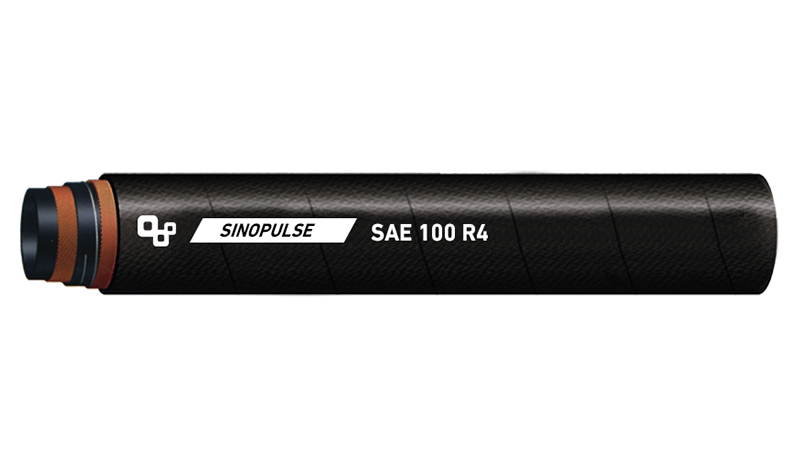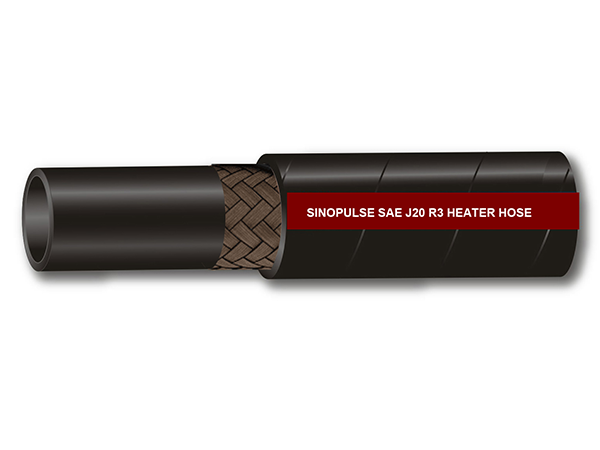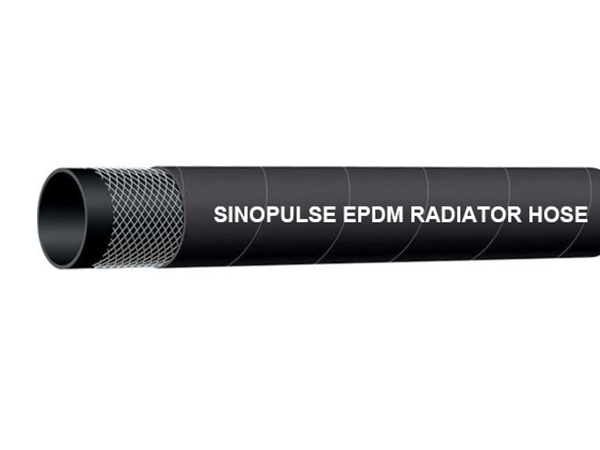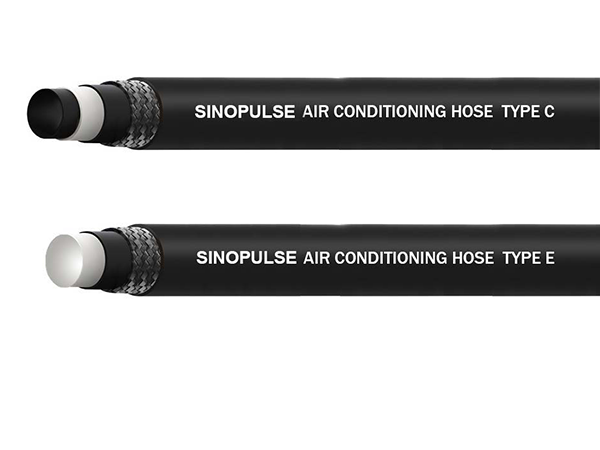As a professional automotive hose manufacturer, Sinopulse presents the most common automotive hoses you will come across when working on your vehicle in this article.

Materials used in automotive hose construction
To withstand the demands of different vehicle systems, automotive hoses are constructed using materials with specific properties tailored to their intended functions. Common materials used in automotive hose construction include:
Silicone
Silicone hoses are known for their exceptional heat resistance, making them ideal for high-temperature applications such as coolant hoses in engines. They offer excellent flexibility and are resistant to aging, ozone, and weathering.
Rubber
Rubber hoses are prevalent in various automotive applications due to their flexibility, durability, and resistance to heat and chemicals. They often feature an inner tube made of synthetic rubber, reinforced with layers of fabric or wire for added strength.
Metal
Metal hoses, typically made of stainless steel, are used in specialised applications that require high-pressure resistance or extreme temperature environments. They offer exceptional durability and resistance to corrosion.
Thermoplastics
Hoses made from thermoplastic materials such as nylon or polyurethane exhibit excellent chemical resistance and durability. They are commonly used in fuel and brake systems.
The selection of materials depends on factors such as the intended application, temperature range, pressure requirements, chemical compatibility, and overall performance expectations. Manufacturers carefully consider these factors to ensure that the hoses meet the demanding conditions within automotive systems.
By understanding the crucial role of automotive hoses and the materials employed in their construction, we gain a deeper appreciation for these unassuming yet indispensable components. In the subsequent sections, we will explore specific types of automotive hoses in detail, unravelling their unique characteristics, maintenance considerations, and the vital functions they serve within a vehicle’s intricate systems.
Automotive Hoses Types
Your vehicle is filled with liquids and gaseous vapors, and the primary way to move these liquids and vapors is through hoses. You may already know this, but what you might not know is that nearly every system is designed for a single purpose and is not interchangeable with others. Therefore, understanding the types of automotive hoses is especially important. Below are the most common types of hoses used in vehicles.

Fuel Hose
Fuel hoses are reinforced rubber hoses in vehicles, used to transport fuel from the tank to various parts of the vehicle (usually the fuel pump). Fuel hoses come in various sizes and pressure ranges, designed for different types of vehicles, from lawnmowers and agricultural tractors to cars and trucks.
Low-Pressure Fuel Hose - Standard fuel line
Low-pressure fuel systems, such as those used in carbureted vehicles, have a maximum pressure range of 6 to 10 psi. They are quite flexible, easy to cut, and simple to use on most vehicles. Most flexible fuel hoses are made of black nitrile with nylon reinforcement between layers for added strength. These hoses are typically rated for pressures up to 25 psi, which is higher than what is needed for EFI hoses. Standard fuel lines can easily handle gasoline, diesel, biodiesel, ethanol, and petroleum. They can be customized into molded shapes or supplied in coils, allowing you to cut to the desired length.
High-Pressure Fuel Hose
High-Pressure Fuel Hoses are designed for the higher pressures of EFI systems, these hoses typically have a maximum pressure range of 30-100 psi, depending on the hose. The clamps used on these hoses need to be round, as standard flat-band worm drive clamps can cut into the hose. Instead, use rolled-edge clamps specifically designed for EFI applications. Of course, for high-pressure applications, dedicated fittings should be used rather than hose clamps.
Power Steering Hose
Power steering hoses are hydraulic lines designed to carry high-pressure fluids, such as oil, from the power steering pump to the vehicle’s steering rack, before the fluids return at a lower pressure.
The main benefits of this system are easier steering and smoother handling. Therefore, power steering hoses play a vital role in the vehicle's control system.

Power Steering Return Line Hose
The power steering return line hose operates under low pressure. It can be easily cut and secured with standard hose clamps. Your automatic transmission is also a hydraulic hose system, and its fluid needs to be cooled. This is achieved through hard lines connected to the radiator. A rubber line acts as a flex joint, which must be a hydraulic hose. Most modern cars use vehicle-specific specialty lines, while many older cars simply use a length of rubber hydraulic hose. This is a low-pressure line.

Brakes Hose
Brake hoses and lines connect the different components of the hydraulic brake system. Typically, metal brake lines run from the master cylinder to flexible rubber brake hoses. These rubber hoses link the brake lines to the brake calipers on each wheel.
Rubber brake hoses offer excellent braking performance, work within a wide range of temperatures and hydraulic pressures, and are more cost-effective than stainless steel hoses. They are used on the front wheels to accommodate steering and suspension movement, and on the rear wheels to allow for rear suspension travel.

Compressed Air Hose
Some vehicles use compressed air for various systems, such as air suspension, air brakes, and even air horns. This is different from the air hoses you find in stores. These hoses are specifically designed to withstand the harsh conditions on the road and come with special fittings.
Coolant Hose
The cooling system in a vehicle keeps the engine cool while generating a significant amount of heat. It consists of a radiator, water pump, radiator cap, cooling fan, heater core, overflow tank, thermostat, hoses, and freeze plugs. The coolant hoses play a crucial role in transporting the coolant between the radiator and the engine. So coolant hoses come in two flavors: heater hose and radiator hose. The hoses are made the same, but the sizes are real difference.

Heater Hose
Heater hoses typically come in diameters of ½, 5/8, and ¾ inches, with various types available ranging from standard to heavy duty. Heavy-duty hoses offer additional protection against exterior wear and damage. All heater hoses are reinforced with nylon cords for enhanced durability. They can be molded into specific shapes or provided as straight lengths, ready to be custom-cut from a spool. It's important to note that coolant hoses should never be used with any type of fuel. Inside a heater hose, you can see the edges of the nylon cords. The thin wall and sparse cord construction indicate that these hoses are designed for low-pressure applications.

Radiator Hose
Radiator hoses are also reinforced with cords, but they are usually molded to shape. This helps prevent kinking and ensures better flow. These hoses typically range from 1 inch to 3 inches in diameter and are designed to resist collapsing. Some radiator hoses include large springs inside to prevent collapse. When hot coolant cools, it can create a vacuum and cause the hose to collapse. Radiator hoses are much larger in diameter and thinner than heater hoses. Often, they have a coiled spring inside to maintain their shape as temperatures change.


A/C Hose
Car air conditioning (AC) systems play a vital role in keeping us comfortable during hot summer days or in any weather condition. There are two types of air conditioning hoses - barrier and non-barrier. This is for the two main types of air conditioning refrigerants. The modern R134a/ R1234yf types have smaller molecules than the older R12. If you put R134a or R1234yf into an R12 non-barrier hose, the gas will slowly seep through the hose itself because the molecules are too small. The R12 molecules are larger than the hose molecules, so they won't seep out. R134a and R1234yf require barrier hoses, which use a plastic liner that contains the refrigerant.

Barrier A/C Hose
The Barrier Hose was designed specifically for the new replacement refrigerant of "R134a/ R1234yf ". The air conditioning industry also conducted research on system leaks and determined that a better refrigerant hose was needed. As a result, new standards for refrigerant hose design were drafted and outlined in the SAE (Society of Automotive Engineers) specification. We call this new hose the "Barrier" hose. The Barrier Hose has an additional lining (non-plasticized nylon copolymer) inside the hose that reduces the permeation (leakage) rate of the refrigerant.
Non-Barrier A/C Hose
Non-Barrier A/C Hose is for R12 air conditioning refrigerants.
Vacuum Hose
Even modern cars still use vacuum hoses, though less than older cars. Vacuum hoses can be rubber, PVC, or silicone. Vacuum hoses are capable of withstanding 25psi and are designed for vacuum, windshield washer fluid, and radiator overflow.

Conclusion:
In this article, we’ve covered the different types of automotive hoses and their essential roles in vehicles. From fuel hoses to brake hoses and air conditioning hoses, each one plays a crucial part in ensuring the safety and performance of your vehicle.
At Sionpulse, we specialize in providing high-quality automotive hoses that meet global standards. With years of experience in the industry, we offer a wide range of durable and reliable hoses tailored to your needs. Whether you are an OEM or working in the aftermarket, we can provide the right solution for you.
When you choose Sionpulse, you are choosing performance, durability, and peace of mind. Our products are designed to keep your vehicle running smoothly for years to come.
Contact us today to learn more about our products. Let Sionpulse support your needs and help you deliver the best to your customers.










